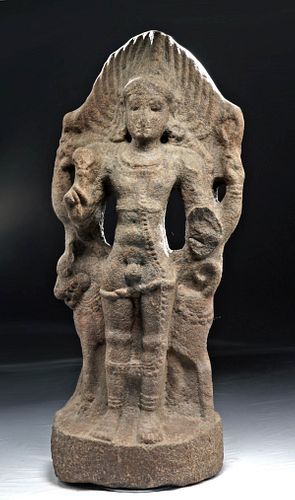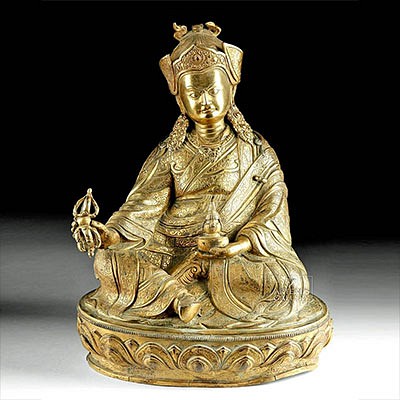14th C. Indian Tamil Nadu Temple Figure Bhairava + Dog
Lot 79
About Seller
Artemis Fine Arts
686 S Taylor Ave, Ste 106
Louisville, CO 80027
United States
Selling antiquities, ancient and ethnographic art online since 1993, Artemis Gallery specializes in Classical Antiquities (Egyptian, Greek, Roman, Near Eastern), Asian, Pre-Columbian, African / Tribal / Oceanographic art. Our extensive inventory includes pottery, stone, metal, wood, glass and textil...Read more
Estimate:
$15,000 - $20,000
Absentee vs Live bid
Two ways to bid:
- Leave a max absentee bid and the platform will bid on your behalf up to your maximum bid during the live auction.
- Bid live during the auction and your bids will be submitted real-time to the auctioneer.
Bid Increments
| Price | Bid Increment |
|---|---|
| $0 | $25 |
| $300 | $50 |
| $1,000 | $100 |
| $2,000 | $250 |
| $5,000 | $500 |
| $10,000 | $1,000 |
| $20,000 | $2,500 |
| $50,000 | $5,000 |
| $100,000 | $10,000 |
| $200,000 | $20,000 |
About Auction
By Artemis Fine Arts
Mar 11, 2021
Set Reminder
2021-03-11 12:00:00
2021-03-11 12:00:00
America/New_York
Bidsquare
Bidsquare : Art of Asia | Antiquity to Present
https://www.bidsquare.com/auctions/artemis-gallery/art-of-asia-antiquity-to-present-6497
Featuring antiquities, ancient and works of art ranging from the third millennium BCE to the present from China, Japan, South and Southeast Asia, and Korea. Including jades, bronzes, lacquer, textiles, paintings, prints, sculpture, ceramics, metalwork, and other art forms in other media. Artemis Fine Arts info@artemisgallery.com
Featuring antiquities, ancient and works of art ranging from the third millennium BCE to the present from China, Japan, South and Southeast Asia, and Korea. Including jades, bronzes, lacquer, textiles, paintings, prints, sculpture, ceramics, metalwork, and other art forms in other media. Artemis Fine Arts info@artemisgallery.com
- Lot Description
Central Asia, South India, Tamil Nadu, Vijayanagar Period, ca. 14th to 16th century CE. A mesmerizing, enormous dark grey granite temple figure, unusually carved in the round, depicting Bhairava, the Hindu deity who destroys fear. The figure stands on a large, round pedestal, with an openwork, carved backing featuring a three-dimensional figure of the god's mount, a dog. This animal is shown in profile behind Bhairava, and is also carved around the back of the sculpture, standing pertly, with its pointed ears up and its tail curled at its back. Carved decoration gives it the appearance of wearing a jeweled collar. Bhairava - also known as the god who is beyond fear - stands in front of the dog, with a large, raised mandorla behind his head. He is richly adorned with carved jewelry and stands with one arm raised, holding one of his attributes. He is otherwise nude. Although time has smoothed his features, his deepset eyes are still clear, gazing out at the viewer. Size: 11" L x 22.5" W x 46" H (27.9 cm x 57.2 cm x 116.8 cm)
South Indian life during the Vijayanagar Empire - a Hindu monarchy - was largely agrarian, with communities centered around granite temples covered in dramatic carvings of gods and saints. Hampi is the most famous of these temple sites, a massive stone complex that today is a UNESCO World Heritage Site. This carving was made to grace such a temple. Crispin Branfoot, describing the architecture of this period, writes, "Entering the Antal temple in Srivilliputtur after sunset is an eerie experience. After the glowing lights and noise of the bazaar, the corridors leading to the heart of the temple are quiet and dark. Tall columns line the corridor and huge figures emerge out of the columns themselves. There are fierce sword-wielding gods killing diminutive demons, and lion-headed monsters rearing up bearing their sharp claws, alongside more peaceful figures of dancing women and the multi-armed Krsna [Krishna] playing his flute" (Artibus Asiae, Vol. 62, No. 2 (2002), pp. 189). Ritual dance was an integral part of ceremonies in these temples, and tall figures like this one would have been included in the dances, draped in red garlands and presenting quite a frightening countenance!
Mr. Swope was a serious collector of Indian antiquities and traveled extensively through India, living in Bombay (Mumbai) in the 1960s. It was there he spent two and a half years in the Peace Corps, where he set up a legal aid society, and met many lifelong friends. Later in life, after a long and rewarding career, he immersed himself in his philanthropic and environmental work in Westchester County. Mr. Swope’s collection was purchased over decades of travel and numerous trips to India, many from Natesan’s Antiqarts, in Mumbai. He befriended Kalesan Natesan and his family whilst he was in the Peace Corps. This friendship and mutual adoration for Indian art was a catalyst for Mr. Swope’s collecting.
Provenance: private New York, New York, USA collection; ex-collection of David Swope, Westchester, New York, USA, 1960s to 1990s. For more on Mr. Swope see above.
All items legal to buy/sell under U.S. Statute covering cultural patrimony Code 2600, CHAPTER 14, and are guaranteed to be as described or your money back.
A Certificate of Authenticity will accompany all winning bids.
We ship worldwide and handle all shipping in-house for your convenience.
#149220The figure is unrepaired and unrestored. Loss to one of the arms and to the phallus. The surface is weathered and the features somewhat smoothed, but the form is still clear. Light deposits on surface.Condition
- Shipping Info
-
All shipping is handled in-house for your convenience. Your invoice from Artemis Gallery will include shipping calculation instructions. If in doubt, please inquire BEFORE bidding for estimated shipping costs for individual items.
-
- Buyer's Premium



 EUR
EUR CAD
CAD AUD
AUD GBP
GBP MXN
MXN HKD
HKD CNY
CNY MYR
MYR SEK
SEK SGD
SGD CHF
CHF THB
THB














